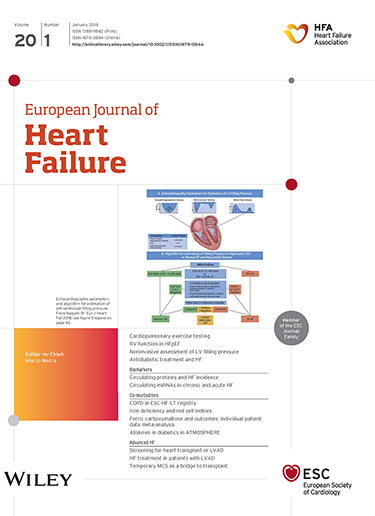Mitochondrial targets in ischaemic heart disease and heart failure, and their potential for a more efficient clinical translation. A scientific statement of the ESC Working Group on Cellular Biology of the Heart and the ESC Working Group on Myocardial Function
IF 16.9
1区 医学
Q1 CARDIAC & CARDIOVASCULAR SYSTEMS
引用次数: 0
Abstract
Acute myocardial infarction (MI) remains a major cause of death and disability worldwide. No adjuvant treatment has yet been fully validated in patients to limit the progression from the initial tissue damage due to acute MI, to the development of heart failure. However, mitochondria have long been demonstrated to be a key target for cardioprotective strategies to reduce cell death that leads to left ventricular dysfunction and ultimately heart failure. While pre-clinical studies have investigated several mitoprotective strategies targeting different mitochondrial functions, such as oxidative stress or permeability transition pore opening, none have shown successful clinical translation so far. In this European Society of Cardiology scientific statement, we present recent research advances in the understanding of the mitochondrial alterations occurring in MI and in the discovery of key components of mitochondrial structure and function in order to improve drug development. We discuss the reasons for the failure of clinical translation and the remaining obstacles that need to be addressed, including timing of drug administration, tissue bioavailability and efficient mitochondrial targeting, together with the mitochondrial impact derived from risk factors, comorbidities and comedications. Taken together, this scientific statement aims to provides a consensus opinion from clinicians and basic scientists to translate some of the most promising mitoprotective targets into the clinical setting to protect against MI and heart failure.

缺血性心脏病和心力衰竭的线粒体靶点及其更有效的临床转化潜力。ESC心脏细胞生物学工作组和ESC心肌功能工作组的科学声明
急性心肌梗死(MI)仍然是世界范围内死亡和残疾的主要原因。尚未有辅助治疗在患者中得到充分验证,以限制由急性心肌梗死引起的初始组织损伤到心力衰竭的进展。然而,线粒体长期以来一直被证明是心脏保护策略的关键目标,以减少导致左心室功能障碍和最终心力衰竭的细胞死亡。虽然临床前研究已经研究了几种针对不同线粒体功能的线粒体保护策略,如氧化应激或通透性过渡孔打开,但迄今为止还没有显示出成功的临床转化。在这份欧洲心脏病学会的科学声明中,我们介绍了心肌梗死中线粒体改变的最新研究进展,以及线粒体结构和功能关键成分的发现,以改善药物开发。我们讨论了临床转化失败的原因和需要解决的其他障碍,包括给药时间、组织生物利用度和有效的线粒体靶向,以及来自危险因素、合并症和药物的线粒体影响。综上所述,这一科学声明旨在为临床医生和基础科学家提供共识意见,将一些最有希望的有丝分裂保护靶点转化为临床环境,以预防心肌梗死和心力衰竭。
本文章由计算机程序翻译,如有差异,请以英文原文为准。
求助全文
约1分钟内获得全文
求助全文
来源期刊

European Journal of Heart Failure
医学-心血管系统
CiteScore
27.30
自引率
11.50%
发文量
365
审稿时长
1 months
期刊介绍:
European Journal of Heart Failure is an international journal dedicated to advancing knowledge in the field of heart failure management. The journal publishes reviews and editorials aimed at improving understanding, prevention, investigation, and treatment of heart failure. It covers various disciplines such as molecular and cellular biology, pathology, physiology, electrophysiology, pharmacology, clinical sciences, social sciences, and population sciences. The journal welcomes submissions of manuscripts on basic, clinical, and population sciences, as well as original contributions on nursing, care of the elderly, primary care, health economics, and other related specialist fields. It is published monthly and has a readership that includes cardiologists, emergency room physicians, intensivists, internists, general physicians, cardiac nurses, diabetologists, epidemiologists, basic scientists focusing on cardiovascular research, and those working in rehabilitation. The journal is abstracted and indexed in various databases such as Academic Search, Embase, MEDLINE/PubMed, and Science Citation Index.
 求助内容:
求助内容: 应助结果提醒方式:
应助结果提醒方式:


